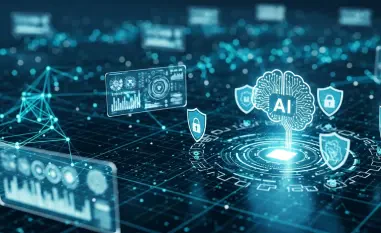Since the COVID-19 pandemic disrupted traditional business operations, enterprises have increasingly leaned on hybrid environments, complex network architectures, and multicloud infrastructure to maintain their digital functions. With over 72% of organizations using multicloud applications, ensuring comprehensive visibility and context poses significant challenges for security professionals aiming to thwart sophisticated threats. It is crucial to secure digital assets and prevent attackers from taking advantage of any security loopholes and cloud misconfigurations. The proliferation of Artificial Intelligence (AI) in cyber-attacks necessitates a robust defense mechanism to keep attackers at bay. By implementing seven critical practices, organizations can reinforce their cloud security posture and significantly mitigate potential security risks.
1. Minimize the Organization’s Cloud Attack Surface
First and foremost, reducing the attack surface does not necessarily mean decreasing the number of cloud applications in an enterprise. It involves identifying and mitigating vulnerabilities that attackers could potentially exploit. If bad actors are leveraging AI to bolster their attacks, it stands to reason that organizations should similarly adopt AI in their cloud security strategies. By deploying AI-based behavior profiling, a Security Operations Center (SOC) can reduce the attack surface, automate application workflows, mitigate threats, and remediate after successful attacks. This AI-driven approach provides real-time insights and improves the overall responsiveness of the defense infrastructure.
Besides AI-based profiling, a comprehensive audit of existing cloud applications and services is essential. Organizations should identify redundant or unused applications and services and eliminate them to ensure they do not provide entry points for cyber attackers. Regular updates and patching cycles should be strictly adhered to for all software components to prevent the exploitation of known vulnerabilities. This approach minimizes the chances of attackers finding and exploiting unpatched systems. Furthermore, organizations should adopt strong encryption standards for data at rest and in transit, which adds an additional layer of security to protect sensitive information from being intercepted or accessed by unauthorized parties.
2. Employ AI for Predictive Remediation
AI tools play a crucial role in enabling quicker threat detection, investigation, and response. A healthy cloud security posture must incorporate Machine Learning (ML)-based User and Entity Behavior Analytics (UEBA) tools, which are effective at identifying anomalous behavior around the network, investigating potential threats rapidly, and automating responses to mitigate and remediate attacks. Security professionals aim to find vulnerabilities before an attack transpires, and AI tools significantly aid in achieving this objective by analyzing vast amounts of data and recognizing patterns indicative of potential threats.
Predictive remediation powered by AI extends beyond simple threat detection. A key advantage is its ability to proactively defend against potential attacks by predicting and addressing vulnerabilities beforehand. For instance, AI can assess historical data and identify trends that might lead to future breaches. Based on these insights, organizations can prioritize strengthening their defenses in areas more prone to attacks. Interactive machine learning models continually adapt to new threat landscapes, providing enhanced accuracy in anticipating and neutralizing emerging threats. This proactive approach not only fortifies cloud security but also optimizes resource allocation, ensuring critical assets receive heightened protection.
3. Implement Identity Mapping to Enhance Cloud Security Threat Detection
As enterprises increasingly move to the cloud, identity security is becoming more significant, often complementing or even surpassing endpoint security. Security professionals are shifting their focus to who is behaving anomalously, rather than how, where, or why such behavior occurs. By effectively mapping cloud activities to users within the network, security personnel can derive contextual data by monitoring who accessed which resources, data, and applications. This identity-centric approach bolsters threat detection and provides security teams with critical insights needed to swiftly address and resolve security events.
Identity mapping facilitates a more granular level of monitoring and control, enabling organizations to implement strict access controls based on user roles and responsibilities. This ensures that employees only have access to the data and applications necessary for their job functions, thereby reducing the risk of insider threats and unauthenticated access. Advanced identity management solutions incorporate multifactor authentication (MFA) and single sign-on (SSO) capabilities, which further enhance security by requiring additional verification steps and streamlining the authentication process. Regularly reviewing access logs and conducting periodic audits of user permissions are vital practices to maintain the integrity of the identity mapping framework.
4. Depend on a Centralized Platform to Investigate Threats Across a Multicloud Environment
When a threat occurs in the cloud, assessing its potential impact across a distributed or multitenant surface can be challenging. Leveraging a centralized platform for threat investigation provides security personnel with a unified response center capable of automating workflows and orchestrating with different cloud applications. This integrated approach reduces the Mean Time to Resolve (MTTR) incidents and threats, enhancing the overall efficiency of the defense mechanism. Centralized platforms consolidate data from various sources, presenting security teams with a comprehensive view of the security landscape and streamlining the process of threat investigation and mitigation.
Centralized platforms also offer advanced analytics and visualization tools that enable security professionals to identify patterns and correlations between different security events. These insights are crucial for detecting sophisticated attacks that may involve multiple stages and vectors. By providing a holistic view of the security environment, centralized platforms help security teams prioritize incidents based on their severity and potential impact, ensuring that critical threats are addressed promptly. Additionally, these platforms often integrate with existing security tools and solutions, allowing organizations to leverage their current investments and enhance their overall security posture without significant disruptions or additional costs.
5. Correlate Network Events with Cloud Activities
Analyzing data from network and cloud services allows security professionals to identify patterns, relationships, and potential threats. It is crucial that an enterprise’s correlation rules for cloud security data are well-designed, tested, and carefully implemented to ensure effectiveness. By correlating access and security logs from various cloud applications, security personnel can detect attempts at data exfiltration, unusual traffic patterns, anomalous account usage, or unauthorized access to cloud storage. These correlations are vital for identifying and mitigating complex cyber threats that may span multiple vectors within the cloud environment.
For instance, if a SOC professional is investigating potential customer data exfiltration from a cloud-based Customer Relationship Management (CRM) tool, they would want to correlate the logs of that CRM tool with the logs of other cloud applications, such as email or team communication tools. Such a correlation could reveal a compromised user account or exfiltration of data via the CRM tool. Properly correlating network events with cloud activities enables security teams to construct a comprehensive threat profile, facilitating more effective incident response and remediation strategies. This approach also helps organizations comply with regulatory requirements by ensuring that all relevant security events are logged and analyzed.
6. Eradicate Shadow IT and Regularly Conduct Cloud Security Risk Assessments
The rise of shadow IT, characterized by the use of unsanctioned applications across the network, has led to significant security vulnerabilities and potential threats, especially in the wake of the pandemic. It is crucial for security personnel to frequently perform cloud security risk assessments and audits to identify and mitigate risks associated with shadow IT. By taking a bottom-up approach, Chief Information Security Officers (CISOs) can gain visibility into granular components and then progress to assess the overall security posture of the network. This ensures that no potential threats are overlooked, and the security framework remains robust and resilient.
Regular risk assessments provide valuable insights into the effectiveness of existing security measures and highlight areas that may require additional attention or resources. These assessments should encompass a comprehensive review of the organization’s cloud infrastructure, including cloud-native applications, third-party integrations, and potential vulnerabilities introduced by shadow IT. By identifying and addressing these risks, organizations can fortify their cloud security defenses and minimize the likelihood of successful cyber-attacks. Additionally, conducting regular security audits helps ensure compliance with industry standards and regulations, demonstrating the organization’s commitment to maintaining a secure and trustworthy digital environment.
7. Establish a Well-Defined Incident Response Plan
AI tools are essential for enhancing threat detection, investigation, and response times. To maintain a robust cloud security posture, it’s crucial to incorporate Machine Learning (ML)-based User and Entity Behavior Analytics (UEBA) tools. These tools excel at identifying unusual network behavior, rapidly investigating potential threats, and automating responses to mitigate attacks. Security experts strive to uncover vulnerabilities before any attack occurs, and AI significantly aids this effort by processing large volumes of data to detect patterns that may suggest potential threats.
AI-powered predictive remediation goes beyond basic threat detection. Its main benefit is proactively defending against future attacks by predicting and addressing vulnerabilities in advance. AI can analyze historical data to identify trends that might lead to breaches. With these insights, organizations can prioritize enhancing defenses in areas most vulnerable to attacks. Interactive machine learning models adapt to new threat landscapes, providing improved accuracy in neutralizing emerging threats. This proactive strategy not only strengthens cloud security but also optimizes resource allocation, ensuring critical assets receive the most protection.













